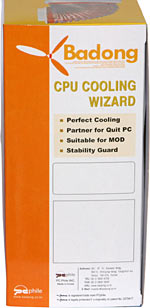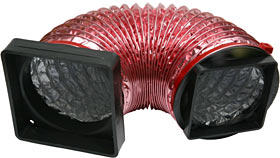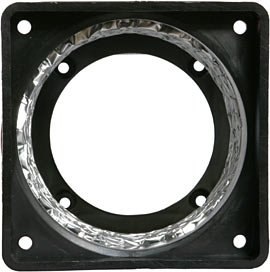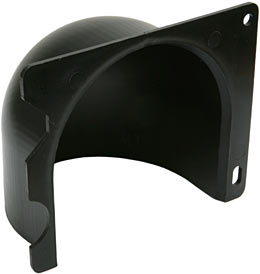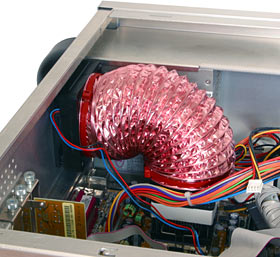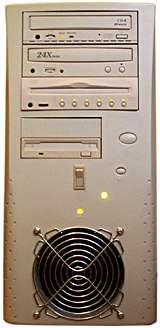
Badong CPU Cooling Wizard
Review date: 15 January 2003.Last modified 03-Dec-2011.
First up, the executive summary.
The Badong CPU Cooling Wizard is a shiny duct thing that lets you connect the top of your CPU cooler to the 80mm exhaust fan that most PC cases have these days. It lets you use a fan in that location as an inlet fan, to deliver outside air directly to the CPU cooler (whose fan probably blows downwards as standard, and can probably be flipped if it doesn't). You also get a "chimney" deflector widget to screw onto the back of your PC's power supply, to stop its warm exhaust air from being sucked straight back into the duct. It's all quite easy to install (provided you buy the model of Badong that suits your computer), and it does actually work.
Executive summary concludes.
And now, the thought that strikes you the first time you clap eyes on this thing.
This product seems, on the face of it, deeply silly.
Take the name, for starters. "Badong" may sound mellifluous if your native language is Korean, but to English-speakers it may most charitably be described as the sound of a small dog colliding with an empty galvanised steel rubbish bin, and it evokes a number of other peculiar mental associations.
And then, there's the packaging.
The front of the box doesn't look too weird - "Heat free! You can get many possibilties." isn't that bad, by world standards - but the small print under the product name is, um, poetry.
The poetry's about the worst of it; it's repeated on all of the other faces of the box...
...along with some more explanatory rambling on the back.
Oh, and it's apparently a "Partner for Quit PC". Thank you.
I include these box-shots for the benefit of customers who won't get a box with their Badong. Here in Australia, Aus PC Market's selling them, but if all you buy's a Badong, then Aus PC will pack it more sensibly than the manufacturers. There's a lot of empty air space in the standard Badong box, and Aus PC include shipping in their $AU45.10 price for the things, and are unwilling to ship air, since most of their customers already seem to have an adequate supply.
If you buy a CPU cooler or some other small item along with your Badong, then you'll get the goofy box, with your whole order packed in it. Otherwise, you'll get the product, but more boring packaging.
Aaanyway, there are four kinds of Badong. They differ only in the CPU-cooler end of the duct; the other end of each Badong has a bracket that fits over the top of an 80mm fan, with four holes that line up with the fan's own mounting holes.
The S-60 model of Badong is for use with regular 60mm-fan coolers - which covers pretty much every cooler for Socket 370 and Socket A. Its CPU cooler endpiece looks like the other end, only smaller.
The S-80 works with 80mm-fan coolers - both ends of the duct are the same. 80mm-fan CPU coolers are rarer than 60mm ones, but they're far from unknown; an 80mm fan lets you get respectable airflow with little noise, or truly monstrous airflow if you're pushing the overclocking envelope.
Then there's the P-60 and P-70, made for Socket 478 coolers with 60mm and 70mm fans, respectively. Most P4 coolers are 70mm units. These two both have a clip-on no-screws CPU cooler end, made to engage the two basic kinds of standard P4 cooler. If you're using an after-market P4 cooler with a 70mm fan, you could probably adapt the P-70 onto it, but you'd need a bit of tape.
The various Badongs come with slightly different mounting hardware, but it's adequate to the task; the S-60, for instance, gives you a couple of fat high-pitch screws suitable for screwing into two corners of a fan, through either Badong end piece, plus a couple of two-part push-in expanding-pin retaining widgets, which do the same job only more gently.
This is an S-60's duct. It is, essentially, just a short and brightly coloured piece of spiral-wire foil-covered air duct, with fan adapters on the ends. It's very flexible and elastic, up to the concertina extension limit of the foil. You can stretch it to a total length of about 32cm (12.5 inches) counting the end pieces, compress it to less than 9cm (3.5 inches), and it can bend tightly enough that the two ends can each rest flat on a table, without straining the duct.
If you do try to over-stretch the duct, you'll find it quite hard to hurt; the flexible part is strong, and it's fixed to the end pieces with well tightened nylon zip ties.
The duct's also covered with insulative lacquer, so it won't short out stuff on your motherboard, should it touch it. It ought not to anyway, mind you; in an ordinary case, it should just rise from the top of the CPU cooler and bend to the back panel, and not go anywhere near the mobo.
Here's the S-60 duct, collapsed together and viewed from one end. You can see the fan mounting holes, and the fact that the concertinaed duct is wide enough that it doesn't impinge significantly into the air flow cross-section of the 80mm end, let alone the 60mm one. A bend in the duct will hold up the air a bit, but the duct itself is pleasingly wide.
This is the chimney for the PSU. It's easy enough to attach; you just use a couple of the PSU's standard mounting screws.
The whole installation procedure is covered very well in the online instructions, which include unusually good hand-modelled illustrations. The instructions can't cover all the little details of getting a duct installed in every PC case out there, but the flexibility of the duct and the simple mounting hardware ought to make it possible.
Well, that's the theory, anyway.
I decided to try the S-60 out in a deliberately awkward PC. It's got a Lian Li PC-60 case (as reviewed here), and the CPU has an Alpha PAL6035 cooler (as reviewed here) on it.
The PC-60 and its successor, the PC-60USB, are both great cases, but they have a separate plate for power supply mounting (which, I thought, might make installing the chimney tricky), and they've got two intake fans and one exhaust fan as standard equipment, which means they generally do a perfectly good job of keeping decently cool air flowing over the CPU cooler, without any extra after-market gear.
The PAL6035 makes things more difficult, because it's a fairly tall cooler - with its full-height fan, and the top of the fan sits about 70mm above the motherboard. The PC-60's rear fan mount is close enough to the CPU location that I thought the Badong duct might not be able to squish into place.
It was a bit of a squeeze, but it worked. The PAL6035's standard fan mounting screws were long enough to go through the Badong adapter and still thread into the heat sink, and the two Badong push-pins fixed the other end of the duct to the (reversed) 80mm fan on the back of the case.
The PAL6035's default fan direction, by the way, sucks air up through the heat sink; most coolers blow air down through it. You could set up a Badong to work in exhaust mode, with the rear case fan blowing outwards and the CPU fan sucking air through the heat sink and into the duct to match, but I turned everything around to bring air in from the outside, since that'd clearly do a better job than still using warm case air to cool the CPU. The Alpha cooler's particular design makes it work a few per cent better in suck mode, but only for a given air temperature; significantly cooler air makes a bigger difference than fan direction.
I left the PC-60's standard low-power rear fan in place, because the PAL6035 I'm using has a modestly powerful 60mm fan on it, whose flow rate isn't very different from that of the case fan. If you've got a CPU cooler with a brutally powerful fan on it, the fan at the other end of the duct should have a similar rated flow, or be even more powerful; otherwise, you'll probably get more airflow if you remove the rear fan.
The duct humps up far enough that it just touches the side panel of the case, but everything still fits together fine, and the duct isn't kinked.
The Badong chimney wasn't a problem, either. But it could be.
The chimney is made to screw onto the back of an ATX PSU, using the two screws on the fan side of the back of the PSU - the side furthest from the IEC mains input connector. This works fine, provided your PSU is installed so that when you look at the computer from behind, the fan's on the right hand side. If the PSU's the other way around - and some cases are built that way - then the chimney is still perfectly installable, but it'll face down, which defeats the purpose.
Many Lian Li cases, including the PC-60, have a reversible plate for PSU mounting; it's easy to flip it around, provided you're not using a PSU with a bottom fan grille that won't breathe properly if it's the other way up. Most cases don't give you a choice about your PSU orientation, though.
Of course, if the PSU's the wrong way around, you can just stick the chimney on with tape or silicone or some other mastic.
Results
The old 1.2GHz Thunderbird Athlon in my test box ran only three degrees Celsius cooler with the Badong and a medium-power 80mm fan (down from a reported 46°C to 43, looping good old software-mode Quake 2 demo loops at a constant 26°C outside-case ambient temperature), but that's about all you could expect, in this situation.
Even a stacked machine in a PC-60 is going to have an internal temperature less than 10°C warmer than the external ambient; if the front fans are set to minimum speed and their filter foam is badly clogged then you could get a bigger difference. But with the fans set to medium speed and a reasonably clean filter, the PC-60-cased computer I'm typing this on (1.6GHz Athlon, GeForce4, various drives and extra cards, cow running all the time, sesame seed bun) only keeps its inside air 6°C warmer than the air outside.
The Badong makers are honest enough to admit that the benefit you'll see from a Badong depends on the difference between your case's interior air temperature and that of the outside air. The better ventilated your case already is, the less improvement a duct to the outside will deliver. Leave the side off your PC and you'll get pretty much no difference at all, unless you're really stacking up the fan power on your Badong.
If you've got a case with ordinary-to-lousy ventilation, though - and there's a good chance you do - then this duct will deliver much more impressive results. You just need somewhere to attach the rear-panel end of the duct. You'd get better results from a Badong and a better case, but a Badong by itself should be a good quick fix.
Cooling isn't the whole of it, either. Using a Badong duct also, as the manufacturers point out on the above-linked page and in its very hard to read graph, lets you use quieter fans to achieve the same amount of cooling. A low-power 80mm case fan and a medium power full-height 60mm fan on an unremarkable CPU cooler should, with this duct, be able to keep a quite seriously overclocked processor more than acceptably cool, even in a completely unremarkable cheap case. To get the same cooling from a regular internal fan, you'd need some ludicrous ten-watt screamer.
Overall
This thing looks good (in a flashy sort of way...), works well, isn't hard to install (although you should bear in mind the chimney-and-PSU-orientation issue), and beats the heck out of the brute-force giant-fan solutions that many overclockers use.
$AU45.10 delivered isn't a bargain basement price for a bit of duct, a "chimney" and some fittings; it wouldn't exactly be high power rocketry to make the same sort of thing yourself. But if your time is worth more than that of the average sixteen year old burger-flipper, I think the Badong's price premium is worth it. This kit, silly though it looks at first, seems likely to Just Work.
Recommended.
Buy one!
Readers from Australia or New Zealand can purchase Badongs from
Aus PC Market.
The regular 60mm version is
here,
the 80mm version is
here,
the 60mm P4 version is
here
and the 70mm P4 version is
here.
(if you're NOT from Australia or New Zealand, Aus PC
Market won't deliver to you. If you're in the USA, try a price search at
DealTime!)


